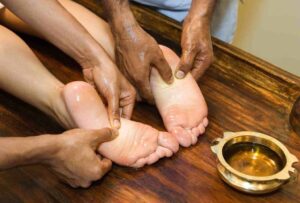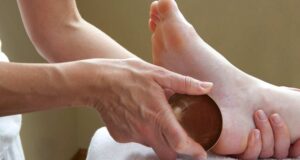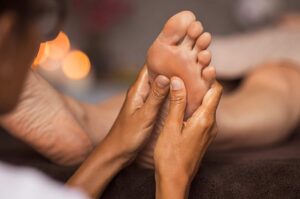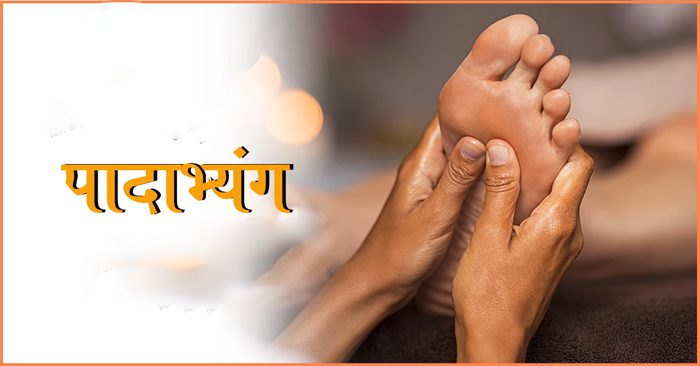Therapy
Benefits of Padabhyanga | Useful in Relaxes and Revitalizes the Central Nervous System, Improves Sleep, Reduces Stress
Table of Contents
Benefits of Padabhyanga – Introduction:
The word Padabhyanga is comprised of two Sanskrit words “Pada+Abhyanga” “Pada” means foot and “Abhyanga” means massage. Thus, it is described as calming and soothing massage therapy, if done properly can keep our body completely revitalized and rejuvenated, and there are multiple benefits of padabhyanga described in different Ayurvedic texts.
This therapy is also recommended as a daily ritual that has to perform before going the bed. Ayurveda narrates that there are about 107 marmas in our body among them five are located in the foot and many times, these are clogged due to any of the reasons. Doing this therapy daily will allow releasing the clogged energies and provides multiple health benefits.
Process / Method of Therapy of Padabhyanga:
This massage therapy is divided into three components:
 The Hand Techniques: It includes rubbing and stroking the foot to generate better cardiovascular circulation in the foot and having multiple benefits of padabhyanga. This also stimulates the flow of energy, directing it in an intended way. Mainly, the sesame seed oil is used for Pada Abhyanga, but in special cases, herbs infused with clarified butter or oil are also used. Cow ghee, Ksheerabala tailam, Pinda tailam, Tiktaka ghritam, Kottamchukkadi tailam, Eranda tailam, Mahamasha tailam, Ksheerabala tailam, Mahanarayana tailam, and Guggulutiktaka ghritam are all medicated oils frequently used for the therapy as well.
The Hand Techniques: It includes rubbing and stroking the foot to generate better cardiovascular circulation in the foot and having multiple benefits of padabhyanga. This also stimulates the flow of energy, directing it in an intended way. Mainly, the sesame seed oil is used for Pada Abhyanga, but in special cases, herbs infused with clarified butter or oil are also used. Cow ghee, Ksheerabala tailam, Pinda tailam, Tiktaka ghritam, Kottamchukkadi tailam, Eranda tailam, Mahamasha tailam, Ksheerabala tailam, Mahanarayana tailam, and Guggulutiktaka ghritam are all medicated oils frequently used for the therapy as well.
 The Kasa Bowl: In this, medicated oil-coated bowls are warmed and the round surfaces are used to massage the foot in circular motions as well as strokes for better circulation. The objective of using Kasa bowls made of copper and tin ensures the elimination of toxins and also it invigorates the nerve endings, releasing the negative energy.
The Kasa Bowl: In this, medicated oil-coated bowls are warmed and the round surfaces are used to massage the foot in circular motions as well as strokes for better circulation. The objective of using Kasa bowls made of copper and tin ensures the elimination of toxins and also it invigorates the nerve endings, releasing the negative energy.
 The Marma Therapy: In Marma therapy, the energy points are handled with care and massage thoroughly, yet gently to ensure that they are activated. By this therapy, the toxins are eliminated, while a path is carved for the elimination of negative energy.
The Marma Therapy: In Marma therapy, the energy points are handled with care and massage thoroughly, yet gently to ensure that they are activated. By this therapy, the toxins are eliminated, while a path is carved for the elimination of negative energy.
Benefits of Padabhyanga:
Following are the some most common benefits of padabhyanga:
- Padabhyangam is known to stimulate some special regions in the brain that effectively work in mental relaxation and improve mental health.
- This therapy is done as a precursor to other Panchakarma treatments that are used to treat gastric problems.
- It effectively helps in relieving pains and aches by relaxing muscles and ligaments.
- Regular practice of Padabhyanga stimulates the vital points on the feet which effectively improves blood and lymph circulation. Thus, this accelerates the removal of waste and helps in body detoxification.
- This therapy effectively works in reducing aches and pain in the lower extremities.
- It helps in removing the contraction of the ligaments, vessels, and muscles of the feet.
- Regular practice of pada abhyanga helps to calm and maintain the “Vata Dosha”.
- In Benefits of Padabhyanga, it promotes healthy eyesight and hearing senses.
- It helps in managing sciatica through enhanced blood circulation and improved peripheral circulation.
- Regular practice provides amazing benefits of Padabhyanga as it helps to overcome general weakness and fatigue from the lower limbs and improves the quality of sleep.
Indications of Padabhyanga:
Padabhyanga effectively works in the health conditions like:
- Hemiplegia and paraplegia
- Diabetic neuropathy
- Hypertension
- Insomnia
- Cramps, sprains, numbness of the feet and legs
- Roughness and cracking of feet
- Depression
- Anxiety
- Epilepsy
Precautions in Padabhyanga:
The below given points should be kept in mind:
- Apply the pressure on the feet if the patient is comfortable. Do not continue the massage if he/she feels any pain or discomfort.
- In swollen feet, this therapy is not advisable to perform.
- If there is any injury on the ankle, toes, or any other part of your foot, the patient needs to consult a trained doctor.
For regular health updates, please follow our Social Pages


